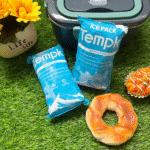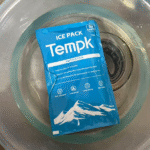Vente en gros Pack De Glace Sèche: Couper 2025 Cost Safely
If you buy a wholesale dry ice ice pack pour l'expédition congelée, vous voulez un temps de maintien maximal au coût total le plus bas. Dans 2025, unit prices typically range from $1.80–$4.20 per pack depending on material and volume, et la plupart des États-Unis. les transporteurs postulent autour $8 per-package dry-ice surcharges. Vous verrez comment dimensionner, étiquette, et validez vos packouts pour dépenser moins sans risquer la température.
-
How to right-size a wholesale dry ice ice pack for 24–120-hour lanes without overpacking
-
Lequel 2025 règles, étiquettes, and surcharges actually affect landed cost
-
Quand un wholesale dry ice ice pack beats retail—and when PCMs beat dry ice
-
Safety moves that stop ruptures, retours, and CO₂ exposure issues
-
Procurement steps to lock price tiers and secure supply in peak seasons
How should you size a wholesale dry ice ice pack for 24–120 hours?
Réponse courte: Planifier 5 à 10 lb de glace sèche par 24 heures for common insulated shippers, then adjust for insulation quality and ambient heat. This simple rule gets you close; confirm with a data logger on your top lanes.
Pourquoi ça marche pour vous: Dry ice absorbs heat as it sublimates. Better insulation cuts the ice you need; thin corrugate demands more. For hot routes, add a 20–30% buffer. This keeps a wholesale dry ice ice pack efficace, protects frozen cores, and avoids costly make-goods. Use a quick calculator first, then validate on live freight.
Pellets vs slabs vs blocks for longer hold time?
Go practical: Boulettes fill voids and chill fast; dalles offer balanced duration; blocs last longest for 3–5-day lanes. Many shippers ring pellets along the walls to intercept heat and cap with a slab near the lid to slow warm-up. This mixed layout stabilizes payload temps with fewer swings during handoffs.
| Formulaire & Cas d'utilisation | Typical Sizes | Behavior | Ce que cela signifie pour vous |
|---|---|---|---|
| Boulettes (1–2 jours) | 3 mm, 10–12mm | Refroidissement rapide, faster loss | Combler les lacunes; even side-wall chilling |
| Dalles (2–3 jours) | ~10 lb slices | Balanced hold | Empilable; easy SOP photos |
| Blocs (3–5 jours) | 50–60 livres | Slowest loss | Lourd; top-loading boosts duration |
Conseils pratiques que vous pouvez utiliser aujourd'hui
-
Two-zone layout: pellets around walls + a slab on top to slow lid losses.
-
Pre-stage cold: pre-freeze product and pre-chill containers for 10–15% longer hold.
-
Espace de tête: partir 10–15% internal free volume to vent CO₂ and prevent bursting.
Caisse de terrain: A bakery switched from gel packs to a wholesale dry ice ice pack (6 kg) in an EPS shipper for 2-day air and cut claims by 30% with similar freight spend.
What really drives your wholesale dry ice ice pack cost?
Fin de compte: Unit price per pound, carrier surcharge, isolation, chaleur ambiante, and risk cost (spoiled shipments) dominate your total. Treat sizing like a formula, not a guess.
Dial the inputs to fit your lane: Start with 5–10 lb/day, upgrade insulation when ambient spikes, and consolidate boxes when surcharges apply. Cela garde votre wholesale dry ice ice pack efficient and your landed cost predictable.
| Saisir | Valeur typique | Pourquoi ça compte | Votre déménagement |
|---|---|---|---|
| Temps de transit | 24–96 h | More hours → more heat load | +3–5 lb per extra day |
| Isolation | EPS/XPS vs corrugate | Better R-value → less ice | Pay for insulation or pay for ice |
| Ambiant | Mild vs heat wave | Higher temps speed loss | Add 20–30% buffer in heat |
| Matériels | Kraft/Mylar/composite | Hold time varies by film | Match material to lane risk |
Wholesale vs retail: when does a wholesale dry ice ice pack win?
Short take: Retail often runs $1.50–$3.00/lb; institutional/wholesale examples have ranged ~$0.71→$1.18/lb in prior programs, reflecting supply shifts. Wholesale gives tiers, delivery windows, and custom forms—key for consistency.
Per-pack economics: Dans 2025, un wholesale dry ice ice pack can land $1.80–$4.20 depending on material (Carton, Mylar, composite), order size, and lane risk. Composite films cost more but extend hold time for high-value pharma and export loads.
How to label and ship a wholesale dry ice ice pack in 2025?
Non-negotiables: Marque «Glace sèche» ou «dioxyde de carbone, solide,” add “UN1845,” and show the net dry-ice weight in kilograms sur le paquet. Appliquer le Classe 9 label and keep packaging vented. Many dry-ice-only air parcels don’t need a full Shipper’s Declaration—operator rules still apply.
Surcharges you should expect: Aux États-Unis, 2025 dry-ice surcharges around $8 par forfait sont courants; some international tables show lower per-shipment fees. Validate your exact lane before tendering.
Safety that actually prevents incidents (Co₂, ventilation, espace de tête)
Plain-language rule: 1 kg of dry ice becomes ~541 L of CO₂ gas comme il sublime. Never create an airtight system. Stage in ventilated areas and keep vents unobstructed. OSHA/NIOSH guidance uses 5,000 ppm as the 8-hour limit and 30,000 ppm short-term—train teams and meter CO₂ in peak season.
Votre liste de contrôle
-
Partir 10–15 % d’espace libre and avoid taping over vent paths.
-
Pin-vent the coolant bag if needed; use vent-friendly shippers.
-
Rotate staff and log exposure near high-volume packout stations.
When should you choose PCMs over a wholesale dry ice ice pack?
Règle: Utiliser un wholesale dry ice ice pack pour ≤−18 °C (ou plus froid) and long lanes; utiliser PCMS pour 0–8 ° C “do-not-freeze” cargo to dodge surcharges and freeze risk. Validate both options on your top routes so you can switch when weather or pricing changes.
2025 developments and trends that affect your choice
Quoi de neuf: Transporteur dry-ice surcharges increased dans 2025 on many U.S. services, acceptance checklists emphasize correct UN1845 + Kg net + Classe 9 visibilité, and CO₂ supply stability remains uneven by region. Suppliers are adding recyclable films and even smart logging to packs for real-time monitoring.
Dernier en un coup d'œil
-
Pricing reality: Wholesale material choice (Kraft/Mylar/composite) now drives the hold-time-to-cost curve.
-
Frais: Expect around $8 par forfait au niveau national; check international variations.
-
Durabilité: More recyclable packaging and efficiency from automation in pack manufacturing.
Perspicacité du marché: Model two packouts per lane (dry ice vs PCM). Keep both validated and switch with seasons or price shocks to protect margin.
Interactif: quick right-size estimator (copie & utiliser)
Conseil: After the math, run one live validation per quarter per lane with a data logger.
FAQ (featured-snippet ready)
Q1: How much dry ice do I need for 2–5 days?
Plan 5–10 lb par jour en fonction de l'isolation et de la chaleur ambiante; add 20–30% in heat waves. Commencez par l'estimateur, then verify on live freight.
Q2: What must my label show for air shipments?
Utiliser «Dioxyde de glace sèche / carbone, solide,” “UN1845,” net kg sur le paquet, avec Classe 9 visible on the same face when space allows; assurer la ventilation.
Q3: How long will different films hold temperature?
Kraft is economical but shorter-hold, Mylar extends duration, and composite films give the longest hold for high-value lanes (often 48–72 h in validated systems).
Q4: What does a wholesale dry ice ice pack really cost me?
The per-pack/ per-lb price is only part; carrier dry-ice fees (often ~$8), niveau d'isolation, and expected spoilage are the bigger levers on landed cost.
Q5: Is dry ice safe to handle in my warehouse?
Yes—with ventilation. 1 kg → ~541 L CO₂; Gardez les évents ouverts, laisser l'espace de tête, and observe OSHA/NIOSH exposure guidance (5,000 ppm twa).
Résumé & étapes suivantes
Points clés: UN wholesale dry ice ice pack wins when you right-size mass, pick the right film, and manage surcharges. Étiquette UN1845 + Kg net + Classe 9, laisser l'espace de tête, and validate quarterly. Keep a PCM alternative ready for 0–8 °C.
Faites ça maintenant:
-
Request tiered quotes for pellets/slabs/blocks with weekend delivery terms.
-
Run the estimator on your top five lanes and A/B test insulation vs ice mass.
-
Update your photo SOP for labels and venting; Former les équipes sur Co₂ Safety.
-
Revoir 2025 surcharge tables and consolidate boxes where possible.
À propos du tempk
We design dry-ice and PCM packouts, expéditeurs isolés, and validation programs for frozen and chilled freight. Our customers typically cut claims 20–40% and reduce landed cost 10–25% by right-sizing coolant and improving insulation. We’ll build you a data-backed standard that scales.
Ready to optimize your next lane? Contact Tempk for a lane-by-lane packout and purchasing plan tailored to your volumes.
























